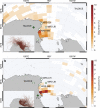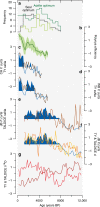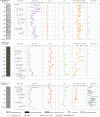Holocene sea ice variability driven by wind and polynya efficiency in the Ross Sea
- PMID: 29109395
- PMCID: PMC5673891
- DOI: 10.1038/s41467-017-01455-x
Holocene sea ice variability driven by wind and polynya efficiency in the Ross Sea
Abstract
The causes of the recent increase in Antarctic sea ice extent, characterised by large regional contrasts and decadal variations, remain unclear. In the Ross Sea, where such a sea ice increase is reported, 50% of the sea ice is produced within wind-sustained latent-heat polynyas. Combining information from marine diatom records and sea salt sodium and water isotope ice core records, we here document contrasting patterns in sea ice variations between coastal and open sea areas in Western Ross Sea over the current interglacial period. Since about 3600 years before present, an increase in the efficiency of regional latent-heat polynyas resulted in more coastal sea ice, while sea ice extent decreased overall. These past changes coincide with remarkable optima or minima in the abundances of penguins, silverfish and seal remains, confirming the high sensitivity of marine ecosystems to environmental and especially coastal sea ice conditions.
Conflict of interest statement
The authors declare no competing financial interests.
Figures







References
-
- Thomas, D. N. & Dieckmann, G. S. Sea Ice: an Introduction to its Physics, Chemistry, Biology and Geology (Blackwell Science Ltd, Oxford, 2003).
-
- Parkinson CL, Cavalieri DJ. Antarctic sea ice variability and trends, 1979–2010. Cryosphere. 2012;6:871–880. doi: 10.5194/tc-6-871-2012. - DOI
-
- de la Mare WK. Changes in Antarctic sea ice extent from direct historical observations and whaling records. Clim. Change. 2009;92:461–493. doi: 10.1007/s10584-008-9473-2. - DOI
-
- IPCC Climate ChangeThe Physical Science Basis. Contribution of Working Group I to the Fifth Assessment Report of the Intergovernmental Panel on Climate Change (eds Stocker, T. F., et al.) (Cambridge University Press, Cambridge, 2013).
-
- Polvani LM, Smith KL. Can natural variability explain observed sea ice trends? New modeling evidence from CMIP5. Geophys. Res. Lett. 2013;40:3195–3199. doi: 10.1002/grl.50578. - DOI
Publication types
LinkOut - more resources
Full Text Sources
Other Literature Sources
Miscellaneous

